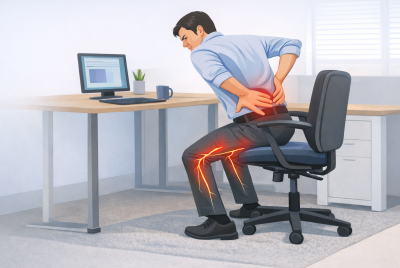What is the Most Successful Treatment for Sciatica?
Discover the most successful treatments for sciatica. From medications to lifestyle changes, learn how to alleviate your sciatica pain effectively. Are you tired of that nagging pain running down your leg? You’re not alone. Sciatica is a common issue that many people face, and finding the most effective treatment can be a game-changer. Let’s dive into what is the most successful treatment for sciatica and the best ways to tackle sciatica.
Understanding Sciatica
What is Sciatica?
Sciatica is a condition characterized by pain that radiates along the path of the sciatic nerve, which extends from your lower back through your hips and down each leg.
Causes of Sciatica
Sciatica typically occurs when a herniated disk, bone spur on the spine, or narrowing of the spine compresses part of the nerve. This causes inflammation, pain, and often some numbness in the affected leg.
Symptoms of Sciatica
Symptoms can range from mild to severe and include pain, numbness, and muscle weakness along the nerve path. The pain can be sharp, burning, or excruciating.
Conventional Treatments for Sciatica
Over-the-Counter Pain Relief
Simple painkillers like ibuprofen or acetaminophen can help reduce inflammation and alleviate pain temporarily.
Prescription Medications
For more severe pain, doctors may prescribe muscle relaxants, anti-inflammatories, or even narcotics. However, these should be used cautiously and under a doctor’s supervision.
Physical Therapy
Physical therapy can help strengthen the muscles around your spine, improve your posture, and increase your flexibility. A physical therapist can design a specific exercise regimen tailored to your needs.
Chiropractic Care
Chiropractors can perform adjustments to align your spine properly, which may help reduce nerve pressure and alleviate pain.
Advanced Treatments for Sciatica
Epidural Steroid Injections
These injections can provide significant relief by reducing inflammation around the irritated nerve, though they are not a long-term solution.
Surgery
Surgery is usually considered a last resort when other treatments fail. Procedures like a microdiscectomy can remove the portion of the disc pressing on the nerve.
Alternative Treatments for Sciatica
Acupuncture
Acupuncture involves inserting thin needles into specific points on the body. It can help reduce pain and promote healing by stimulating the body’s natural painkillers.
Massage Therapy
Regular massages can improve circulation, reduce muscle tension, and promote relaxation, which can help alleviate sciatic pain.
Yoga and Stretching
Gentle stretching and yoga can improve flexibility and strength, which can help reduce the pressure on the sciatic nerve. Poses like the pigeon pose or child’s pose can be particularly beneficial.
Herbal Remedies
Certain herbs and natural blends like turmeric and devil’s claw have anti-inflammatory properties and may help manage pain. However, it’s important to consult a healthcare provider before starting any herbal supplements.
Lifestyle Changes to Manage Sciatica
Exercise
Regular exercise is crucial in managing sciatica. Activities like walking, swimming, and low-impact aerobics can keep your body active without putting too much strain on your back.
Ergonomic Improvements
Ensuring your workspace is ergonomically friendly can prevent sciatica from exacerbating. This includes using supportive chairs, maintaining good posture, and setting up your desk to avoid strain.
Weight Management
Carrying extra weight can put additional pressure on your spine and sciatic nerve. Maintaining a healthy weight through a balanced diet and regular exercise can prevent flare-ups. reduce the stress on your spine, and lower the risk of sciatica.
Combining Treatments for Optimal Results
Personalized Treatment Plans
Combining various treatments tailored to your specific condition often yields the best results. A healthcare professional can help you devise a comprehensive plan.
Holistic Approach
A holistic approach that includes physical therapy, medication, alternative treatments, and lifestyle changes can provide the most effective relief from sciatica.
When to See a Doctor
If your sciatica pain persists for more than a few weeks, is severe, or worsens over time, it’s crucial to see a doctor. Seek immediate medical attention if you experience sudden, severe pain in your lower back or leg, numbness, muscle weakness, or loss of bladder or bowel control. Early intervention can prevent further complications and help determine the most effective treatment plan for your condition.
Frequently Asked Questions (FAQs)
What are the first signs of sciatica?
The first signs often include pain in the lower back or buttock that radiates down the leg, along with tingling or numbness.
What is the most successful treatment for sciatica?
The most successful treatment for sciatica varies per individual but often includes a combination of physical therapy, medications, and lifestyle changes. Advanced options like epidural steroid injections or surgery may be necessary for severe cases. Always consult with a healthcare professional to tailor the best approach for you.
How long does it take to recover from sciatica?
Recovery time varies; mild cases may resolve in a few weeks, while more severe cases could take several months.
Can sciatica go away on its own?
Yes, mild sciatica can improve over time with self-care and proper management. However, persistent symptoms should be evaluated by a doctor.
Is walking good for sciatica?
Yes, walking can help relieve sciatic pain by promoting blood flow and reducing inflammation. It’s important to walk at a comfortable pace and avoid uneven surfaces.
When should I see a doctor for sciatica?
You should see a doctor if your pain is severe, lasts more than a few weeks, or is accompanied by severe numbness, muscle weakness, or bladder/bowel issues.
Extra FAQs Related to What is the Most Successful Treatment for Sciatica?
What is the fastest way to cure sciatica?
While there’s no instant cure, a combination of rest, physical therapy, and over-the-counter pain relievers often provides quick relief. For severe cases, consult a healthcare professional for more targeted treatments.
How should I sleep with sciatica pain?
Sleeping on your side with a pillow between your knees or on your back with a pillow under your knees can help reduce pressure on the sciatic nerve and alleviate pain.
Are there any exercises I should avoid with sciatica?
Avoid exercises that involve heavy lifting, twisting, or bending forward, as these can exacerbate sciatic pain. Focus on low-impact activities and stretching.
Can stress cause sciatica?
While stress itself doesn’t cause sciatica, it can contribute to muscle tension and exacerbate pain. Managing stress through relaxation techniques and regular exercise can be beneficial.
Conclusion: What is the Most Successful Treatment for Sciatica?
Sciatica can be a debilitating condition, but with the right combination of treatments, you can manage the pain and lead a fulfilling life. From medications and physical therapy to alternative therapies and lifestyle changes, there are many paths to relief. Always consult with a healthcare professional to find the best treatment plan for you.
Disclaimer
This article is for informational purposes only and is not a substitute for professional medical advice, diagnosis, or treatment. Always consult with your healthcare provider before starting a new exercise or stretching routine, especially if you have existing back or nerve conditions.
👉 Explore more:
- Newly Discovered Weird Stretch Fixes Back Pain and Sciatica Fast
- What is the Main Cause of Sciatica
- Will Sciatica Go Away





